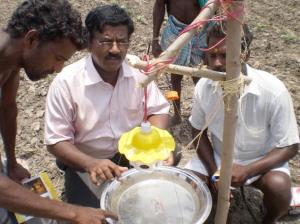
“In spite of being popular as a poor man’s vegetable, brinjal often gets affected by the shoot and fruit borer that are common pests affecting all brinjal growing areas in the country and continue to pose a serious problem to the farmers,” says Mr. P. David Raja Beula, Assistant Director of Horticulture, Kadayam, Tirunelveli, Tamil Nadu. The larvae bore into the tender shoots and fruits, affecting plant growth and make the fruits unfit for marketing. Farmers repeatedly spray several chemicals, or in case of organic methods use the required bio applications on the crop. No permanent solution “But complete control or eradication does not seem possible as the larvae hide in the shoots and fruits and escape the sprays. Naturally farmers tend to over-spray thinking that more spraying effectively controls the pest,” explains Mr. David. Repeated spraying burns a big hole in the already poor farmers’ pocket. In addition to the financial cost incurred for buying the chemicals, excessive application creates a negative impact on the environment, in the harvested vegetables, and poses serious risk to consumers. “Since my daily work involves interacting with farmers, a majority of them growing brinjal, I found myself facing a dead end, when brinjal growers repeatedly asked me to suggest a permanent solution to this pest problem as sprays were not found effective. “During one of my usual field visits I happened to see the normal light traps in the fields for attracting and destroying the insect pests and thought of using the same technology for the brinjal problem.” Modified Accordingly, after a little modification Mr. David installed two wireless light traps as an experiment in a farmer’s field and found that the pests (larvae) got attracted to the bright light and fell into the trap. “I now needed to demonstrate this to farmers lacking previous experience of using a light trap to kill the pest. We knew that convincing them in a single interaction would prove difficult. “I decided to first demonstrate this technology in a farmer’s field and then make him talk to others,” explains Mr. David. Accordingly a farmer from a nearby village got the traps installed in his field. The farmer grew a local variety of brinjal called Ilavambadi (named after a village near Vellore, Tamil Nadu). Pest collection The collection of the pest, which started from three moths gradually (the moths fly into the field during night to lay its eggs on the plant) increased to 500 moths, reducing the pesticide spray from once in seven days to once in 15 days and finally once in 30 days. “This reduced the cost of pesticide consumption from Rs 10, 000 per acre to Rs.7,000 per acre. The wireless light trap costs only Rs. 500 per piece, and two traps are sufficient for an acre. The farmer is able to save Rs. 3, 000 on the cost of pesticide by this,” he says. After erecting the light traps the farmer harvested about 10 tonnes from an acre. The wireless light traps can also be used to control pest in other crops in our country, according to Mr. David. For more details and personal visit readers can contact Mr. P. David Raja Beula, Assistant Director of Horticulture, Kadayam, Tirunelveli, Tamil Nadu, email microeconomicsdavid@yahoo.co.in mobile 9486285704.
